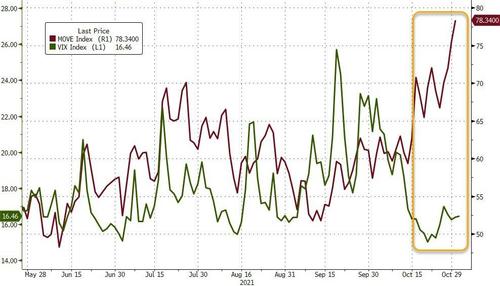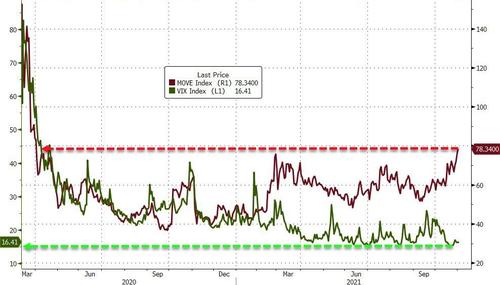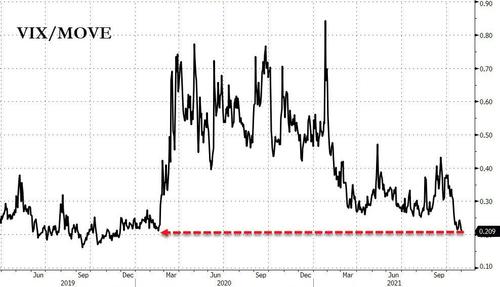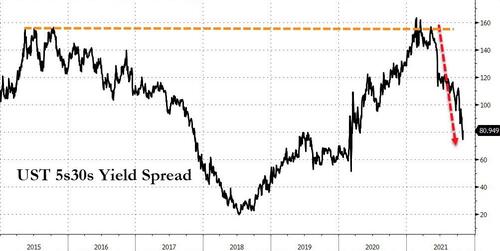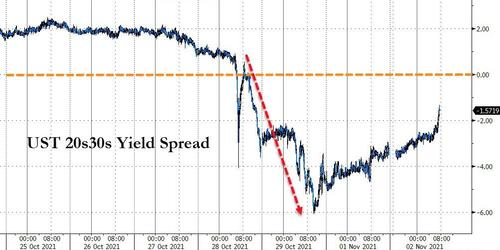Bond Market Volatility Surges To 18-Month-Highs Ahead Of Fed Taper Talk
As LongTail Alpha’s founder, Vineer Bhansali, notes, pension fund managers have started asking him for guidance on how to best protect their portfolios against interest-rate volatility.
“That tells you they are getting worried,” he says. At some point, he adds, “markets are just going to break in some parts. It will be a fun time to trade.”
Nowhere is that fear more evident currently than in Treasury bond options markets.
The MOVE Index, akin to the VIX index on Treasuries, is spiking, signaling investors are increasingly worried about immediate risk surrounding tomorrow’s Fed announcement, most specifically Powell’s potential plans to taper bond purchases.
(The MOVE Index is a yield-curve weighted index of the normalized implied volatility on 1-month Treasury options. It incorporates the weighted average of vols on the current 2Y, 5Y, 10Y, & 30Y bond.)
The spike in the index to the highest levels since April 2020 suggests some front-running in Treasuries is taking place, brokers told Bloomberg’s Alyce Andres (but it could also be linked to major dislocations and low liquidity in the back end of the curve).
Meanwhile, the VIX Index, pricing expected volatility of the S&P 500, trades around 16. In April 2020, when the MOVE Index was near current levels, the VIX was trading at almost 50.
Interestingly, MOVE has normalized back to pre-COVID levels relative to VIX here…
Bloomberg also notes that last week’s massive cheapening in the 20Y bond (and inversion to the 30Y) continues to see aftershocks (reportedly forcing relative-value and hedge funds to liquidate paper, brokers confirm).
The 5s30s curve has collapsed…
And 20s30s is inverted for the first time ever…
Bear Traps recently summarized this dynamic perfectly:
For much of the last two years, price discovery across global government bond yield curves has been suppressed. As we stressed in recent months, “Adam Smith’s hands are being tied behind his back.”
Free markets have not existed in a covid world. Now central banks are pulling away and the moves across the front and long-end of yield curves are colossal. It’s ALL ABOUT the rate of change. In macro rates, the body bags are piling up this week. The losses are enormous across this section of the hedge fund community. As one large whale gets stopped out, he takes the smaller players with him / her. There is a lot more risk out there than meets the eye.
In US rates, the 20 and 30-year bonds both yield 1.77%, we touched inversion today. We are NOT seeing real economic growth, bonds are telling us real demand destruction is here. Inflation has already hiked rates 200bps for the Fed.
So what happens next? We recently put it all together:
-
The liquidity in what is supposed to be the deepest, most liquid market in the world, is collapsing.
-
In a time when the Fed is still injecting $120BN in liquidity every month, we just observed an event that has only happened on prior previous occasions – Oct 2nd 2017, Aug 19th 2020 and Feb 25th 2021. One can only imagine what happens to liquidity when the Fed begins to taper.
-
As liquidity evaporates, rate vol is accelerating and dislocations across the yield curve accelerate, with bond vol surging while equity vol is completely ignoring the turmoil in the bond market. Eventually equity vol catches up to rates.
-
Some extremely levered multistrat hedge funds are reprising LTCM and piling into treasury/futures basis trades – the same trades that blew up spectacularly in Sept 2019 and March 2020.
-
As hedge funds pile into new flattener basis trades, others are liquidating basis steepeners, in some cases at huge margin call inducing losses, which force them to liquidate other performing assets.
-
A positive feedback loop emerges as liquidity shrinks further while volatility rises as the basis trade funnel gets wider, and more enter while those hoping to exit hold off until the last moment.
-
We hit a tipping point where all basis trades are no longer viable as there is simply not enough liquidity to put new trades on. That’s the moment everyone starts rushing for the exits, and as Sept 2019 and March 2020 showed us, that’s precisely the catalyst for a cross-asset crash, as basis trading funds scramble to boost liquidity while repo markets lock up. The result is a surge in volatility in underlying assets (TSYs), but also a freeze in the funding pathways (i.e. repo) that are used by the funds to fund said trades.
-
Eventually, Fed steps in to bail out some of the world’s richest hedge fund managers, usually under the guise of some social calamity, like – for example – a viral pandemic.
We are currently toward the end of step 6 of this checklist.
Tyler Durden
Tue, 11/02/2021 – 10:45
via ZeroHedge News https://ift.tt/3bzbOVb Tyler Durden
